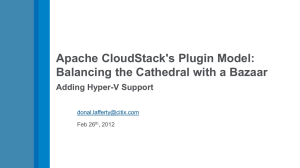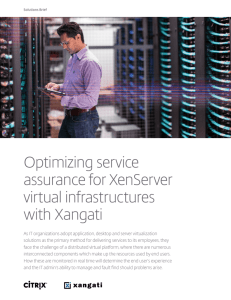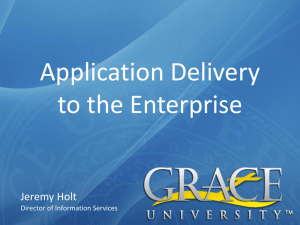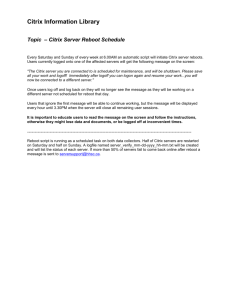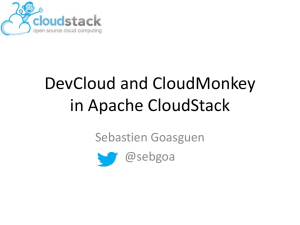virtg - Hypervisor selection - Virtualization Group
advertisement
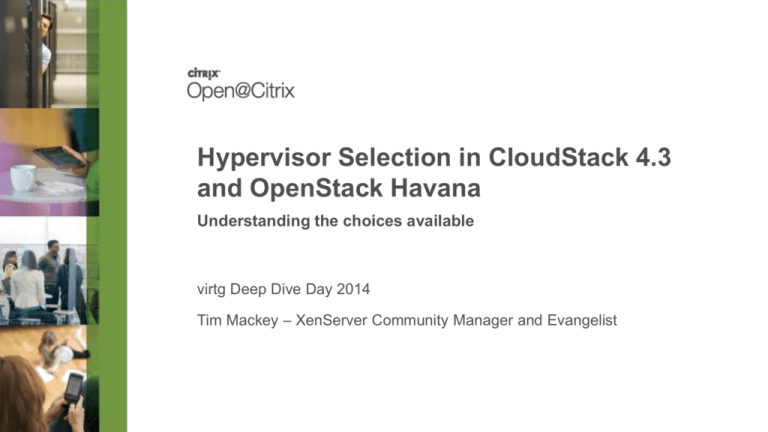
Hypervisor Selection in CloudStack 4.3 and OpenStack Havana Understanding the choices available virtg Deep Dive Day 2014 Tim Mackey – XenServer Community Manager and Evangelist Building a successful cloud What are we trying to accomplish? Service Offerings • Clearly define what you want to offer ᵒ What types of applications ᵒ Who has access, and who owns them ᵒ What type of access • Define how templates need to be managed ᵒ Operating system support ᵒ Patching requirements • Define expectations around compliance and availability ᵒ Who owns backup and monitoring © Citrix 2014. More information at xenserver.org and follow me on twitter @XenServerArmy Define Tenancy Requirements • Department data local to department ᵒ Where is the application data stored • Data and service isolation ᵒ VM migration and host HA ᵒ Network services • Encryption of PII/PCI ᵒ Where do keys live when data location unknown ᵒ Need encryption designed for the cloud • Showback to stakeholders ᵒ More than just usage, compliance and audits © Citrix 2014. More information at xenserver.org and follow me on twitter @XenServerArmy Virtualization Infrastructure • Hypervisor defined by service offerings ᵒ ᵒ ᵒ ᵒ Don’t select hypervisor based on “standards” Understand true costs of virtualization Multiple hypervisors are “OK” Bare metal can be a hypervisor • To “Pool” resources or not ᵒ Is there a real requirement for pooled resources ᵒ Can the cloud management solution do better? ᵒ Real cost of shared storage • Primary storage defined by hypervisor • Template storage defined by solution ᵒ Typically low cost options like NFS © Citrix 2014. More information at xenserver.org and follow me on twitter @XenServerArmy Choice is a good thing…. Apache CloudStack Management Server • Current release: 4.2.1 (4.3 imminent) • Highly scalable • Monolithic architecture • Mostly written in Java • Multi-hypervisor support ᵒ XenServer, KVM, OracleVM, vSphere, Linux Containers, Bare metal ᵒ 4.3 adds: Hyper-V • Strong backing from Citrix, CloudOps, Shapeblue and others © Citrix 2014. More information at xenserver.org and follow me on twitter @XenServerArmy Load Balancer Management Server Management Server MySQL DB Replication Back Up DB Infrastructure Resources OpenStack • Current release: Havana • Scalable in 500 node blocks • Distributed architecture • Mostly written in Python • Multi-hypervisor support ᵒ Group A: KVM ᵒ Group B: Hyper-V, vSphere, XenServer ᵒ Group C: All others deprecated in Icehouse • Strong backing from HP, IBM, RAX, RHT, Canonical, Mirantis, Piston Cloud, Cloudscaling © Citrix 2014. More information at xenserver.org and follow me on twitter @XenServerArmy Leading hypervisor options XenServer 6.2 Feature Source code model Maximum VM Density CloudStack VM Density CloudStack integration OpenStack driver Maximum native cluster size Maximum pRAM Largest VM Windows Operating System Linux Operating Systems Advanced features supported (CloudStack) Advanced features supported (OpenStack) Open Source (GPLv2) 650 (Linux) 500 Direct XAPI calls OpenStack nova-compute domU 16 1 TB 16 vCPU/128GB All Windows supported by Microsoft RHEL, CentOS, Debian, Ubuntu, SLES, OEL ovs, Storage XenMotion, DMC ovs, Storage XenMotion © Citrix 2014. More information at xenserver.org and follow me on twitter @XenServerArmy vSphere 5.5 Feature Source code model Maximum VM Density CloudStack VM Density CloudStack integration OpenStack driver Maximum native cluster size Maximum pRAM Largest VM Windows Operating Systems Linux Operating Systems Advanced features supported (CloudStack) Advanced features supported (OpenStack) Proprietary 512 128 vCenter vCenter – nova-compute node per cluster 32 4 TB 64 vCPU/1TB DOS, All Windows Server/Client Most HA, DRS, vDS, Storage vMotion HA, DRS, vMotion © Citrix 2014. More information at xenserver.org and follow me on twitter @XenServerArmy KVM Feature Source code model Maximum VM Density CloudStack VM Density CloudStack integration OpenStack driver Maximum native cluster size Maximum pRAM Largest VM Windows Operating Systems Linux Operating Systems Advanced features supported (CloudStack) Advanced features supported (OpenStack) Open Source (GPLv2) 10 times the number of pCores 50 CloudStack Agent (libvirt) libvirt driver No native cluster support 2 TB 160 vCPU/2TB Windows XP and higher Varies None None © Citrix 2014. More information at xenserver.org and follow me on twitter @XenServerArmy Microsoft Hyper-V Feature Source code model Maximum VM Density CloudStack VM Density CloudStack integration OpenStack driver Maximum native cluster Size Maximum pRAM Largest VM Windows Operating Systems Linux Operating Systems Advanced features supported (CloudStack) Advanced features supported (OpenStack) Proprietary 1024 1024 CloudStack Agent (C# calling WMI) Use Cloudbase driver 64 4 TB 64 vCPU/1TB All Windows supported by Microsoft RHEL, CentOS, Debian, Ubuntu, SLES, OEL None None © Citrix 2014. More information at xenserver.org and follow me on twitter @XenServerArmy The CloudStack 4.3 world … Defining the network Flat Network – Basic Layer 3 Network Option XenServer vSphere KVM Hyper-V Security Groups Yes- bridge No Yes Yes IPv6 No No Yes No Multiple IPs per NIC Yes Yes Yes Yes Nicira NVP Yes No Yes No BigSwitch VNS Yes No Yes No Public Network 65.11.0.0/16 Security Group 1 65.11.1.2 65.11.1.3 65.11.1.4 65.11.1.5 DHCP, DNS © Citrix 2014. More information at xenserver.org and follow me on twitter @XenServerArmy CloudStack Virtual Router Guest VM 1 Guest VM 2 Guest VM 3 Guest VM 4 Security Group 2 VLANs for Private Cloud Option XenServer vSphere KVM Hyper-V Max VLANs 800 254 1024 4094 IPv6 No No Yes No Multiple IPs per NIC Nicira NVP Yes Yes Yes Yes Yes No Yes No BigSwitch VNS Yes No Yes No MidoKura No No Yes No VPC Yes Yes Yes Yes NetScaler Yes Yes Yes Yes F5 BigIP Yes Yes Yes Yes Juniper SRX No Yes Yes Yes Cisco VNMC No Yes No No Guest Virtual Network 10.0.0.0/8 VLAN 100 Public Network/Internet Public IP 65.37.14.1 © Citrix 2014. More information at xenserver.org and follow me on twitter @XenServerArmy CloudStack Virtual Router DHCP, DNS NAT Load Balancing VPN Gateway 10.1.1.1 10.1.1.1 10.1.1.3 10.1.1.4 10.1.1.5 Guest VM 1 Guest VM 2 Guest VM 3 Guest VM 4 Beyond the VLAN – Network Virtualization Option XenServer vSphere KVM Hyper-V OVS GRE tunnels Yes No No No Nicira STT tunnel Yes Yes Yes No MidoNet No No Yes No VXLAN No Yes Yes No NVGRE No No No No Nexus 1000v No Yes No No Juniper Contrail Yes No No No Palo Alto Yes Yes Yes No © Citrix 2014. More information at xenserver.org and follow me on twitter @XenServerArmy Virtual Private Cloud and nTier Applications Feature PVLAN XenServer Yes - ovs vSphere Yes KVM ovs DC2 Hyper-V No DC1 DC3 VLAN 1 DC4 Web S2S VPN Router VLAN 2 App Private GW VLAN 3 DC5 DC6 DB © Citrix 2014. More information at xenserver.org and follow me on twitter @XenServerArmy Delivering specific network services • KVM ᵒ IPv6 ᵒ Security groups ᵒ Large quantity of VLANs • vSphere ᵒ VXLAN required vSphere Enterprise Plus ᵒ Cisco Nexus 1000v and ASA 1000v require vSphere Enterprise Plus • XenServer ᵒ Security groups ᵒ Large quantity of VLANs ᵒ Juniper Contrail © Citrix 2014. More information at xenserver.org and follow me on twitter @XenServerArmy Instances need a home … Storage, Storage and more Storage Primary Storage Options Feature Local storage NFS SMB Single path iSCSI Multipath iSCSI Direct array Shared Mount Template format SolidFire Plugin NetApp Plugin Zone wide Ceph RBD Clustered LVM XenServer Yes Yes No Yes PreSetup No No VHD Yes Yes No No No vSphere Yes Yes No Yes No VAAI No OVA Yes Yes Yes No No KVM Yes Yes No Yes No No Yes QCOW2 Yes Yes Yes Yes Yes Hyper-V Yes No SMB3 No No No No VHD No No No No No © Citrix 2014. More information at xenserver.org and follow me on twitter @XenServerArmy Host Host Primary Storage Cluster Secondary Storage Options Option XenServer vSphere KVM Hyper-V NFS Yes Yes Yes No Swift(1) Yes Yes Yes No S3 compatible (2) Yes Yes Yes No SMB No No No Yes (1) Requires NFS staging area (2) Can be region wide, but must not have NFS secondary storage in zone Host Host Primary Storage Cluster Pod Secondary Storage Zone © Citrix 2014. More information at xenserver.org and follow me on twitter @XenServerArmy Core virtualization capabilities The limits and features which matter CloudStack Features Feature XenServer vSphere KVM Hyper-V Disk IO Statistics Yes No Yes Yes Memory Overcommit Yes (4x) Yes No No Dedicated resources Yes Not with HA/DRS Yes Yes Disk IO throttling No No Yes No Disk snapshot (running) Yes Yes No No Disk snapshot (pluggable) Partial Partial No No Disk snapshot (Stopped) Yes Yes Yes Yes Memory snapshot Yes Yes Yes No Zone wide primary storage No Yes Yes No Resize disk Offline Online Grow Online No High availability CloudStack Native CloudStack CloudStack CPU sockets 6.2 and higher Yes Yes Yes Affinity groups Yes Yes Yes Yes © Citrix 2014. More information at xenserver.org and follow me on twitter @XenServerArmy Multiple Hypervisor Support in CloudStack • Networking ᵒ Ensure network labels match ᵒ Topology is intersect of chosen hypervisors • Storage ᵒ For system VMs to specific hypervisor type ᵒ Zone with primary storage limited • Operations ᵒ ᵒ ᵒ ᵒ vSphere Datacenter can not span zones Hyper-V may not be mixed with other hypervisors HA won’t migrate between hypervisors Capacity planning at the cluster/pod level more difficult © Citrix 2014. More information at xenserver.org and follow me on twitter @XenServerArmy The OpenStack Havana world … Defining the network The goodness of Neutron (Quantum) Flat Network – Basic Layer 3 Network Option XenServer vSphere KVM Hyper-V Security Groups Yes Yes-NVP Yes No IPv6 No No No No Multiple IPs per NIC Yes Yes Yes Yes Nicira NVP Yes Yes Yes No Firewall rules Yes No Yes No Routing Yes No Yes No Public Network 65.11.0.0/16 Security Group 1 65.11.1.2 65.11.1.3 65.11.1.4 65.11.1.5 DHCP, DNS © Citrix 2014. More information at xenserver.org and follow me on twitter @XenServerArmy CloudStack Virtual Router Guest VM 1 Guest VM 2 Guest VM 3 Guest VM 4 Security Group 2 VLANs for Private Cloud Option XenServer vSphere KVM Hyper-V Max VLANs 800 254 1024 4094 IPv6 No No No No Multiple IPs Yes Yes Yes Yes Guest Virtual Network 10.0.0.0/8 VLAN 100 Public Network/Internet Public IP 65.37.14.1 CloudStack Virtual Router DHCP, DNS NAT Load Balancing VPN Gateway 10.1.1.1 10.1.1.1 10.1.1.3 10.1.1.4 10.1.1.5 © Citrix 2014. More information at xenserver.org and follow me on twitter @XenServerArmy Guest VM 1 Guest VM 2 Guest VM 3 Guest VM 4 Beyond the VLAN – Network Virtualization Option OVS GRE tunnels Nicira STT tunnel VXLAN NVGRE Nexus 1000v Nicira NVP BigSwitch VNS MidoKura Brocade Plumgrid Ryu NEC Cisco VNMC XenServer Yes Yes No No No Yes No No No No No No No vSphere No Yes Yes No Yes Yes No No No No No No No KVM No Yes Yes No Yes Yes Yes Yes Yes Yes Yes Yes Yes Hyper-V No No No No No No No No No No No No No © Citrix 2014. More information at xenserver.org and follow me on twitter @XenServerArmy Instances need a home … Storage, Storage and more Storage Instance Storage Options – Nova and Cinder Feature Template format Local storage NFS Fiber HBA iSCSI iSCSI CHAP Ceph Gluster ZFS XenServer VHD Yes Yes No Yes Yes No No No vSphere VMDK Yes Yes No Yes No No No No KVM QCOW2 Yes Yes Yes Yes Yes Yes Yes Yes Hyper-V VHD Yes Yes No Yes No No No No © Citrix 2014. More information at xenserver.org and follow me on twitter @XenServerArmy OpenStack Features Feature XenServer vSphere KVM Hyper-V Pause VM Yes No Yes Yes Inject networking Guest agent Yes Flat (Debian) Yes Inject file Yes No Yes cloudbase-init Serial console Yes Yes Yes No VNC consoles Yes Yes Yes Yes SPICE console No No Yes No Snapshot Yes Yes Yes Yes Set administrator password Yes No No cloudbase-init Auto configure disk Yes No No No Evacuate host Yes No Yes No Volume swap No No Yes No Volume rate limiting No No Yes No © Citrix 2014. More information at xenserver.org and follow me on twitter @XenServerArmy Multiple Hypervisor Support in OpenStack • Capabilities ᵒ ᵒ ᵒ ᵒ Multiple hypervisor support varies by distro Most deployments are single hypervisor Difficult to schedule instances to compute nodes Use host aggregates • Networking ᵒ Topology is intersect of chosen hypervisors – ML2 helps • Operations ᵒ HA won’t migrate between hypervisors ᵒ Capacity planning at the cluster/pod level more difficult ᵒ Hyper-V does not work with all Neutron plugins © Citrix 2014. More information at xenserver.org and follow me on twitter @XenServerArmy Picking the “best one” When to use which hypervisor… KVM • Primary value proposition: ᵒ Low cost with available vendor support ᵒ Familiar administration model ᵒ Broad feature set with active development in both CloudStack and OpenStack • Cloud use cases: ᵒ Linux centric workloads ᵒ Dev/test clouds ᵒ Web hosting ᵒ Tenant density which dictates SDN options • Weaknesses: ᵒ CloudStack: Requires use of an installed libvirt agent ᵒ Limited native storage options ᵒ No use of advanced native features © Citrix 2014. More information at xenserver.org and follow me on twitter @XenServerArmy Microsoft Hyper-V • Primary value proposition: ᵒ Unlimited Windows Server VM licenses ᵒ Familiar Windows management paradigm • Cloud use cases: ᵒ Windows and Linux workloads ᵒ Dev/test clouds ᵒ .Net application web hosting ᵒ Desktop as a Service clouds • Weaknesses: ᵒ Minimal use of advanced native features ᵒ CloudStack: First introduced with CloudStack 4.3 (not yet released) © Citrix 2014. More information at xenserver.org and follow me on twitter @XenServerArmy vSphere • Primary value proposition: ᵒ Broad application and operating system support ᵒ Readily available pool of vSphere administration talent ᵒ Large eco-system of vendor partners ᵒ CloudStack: Many features are native implementations ᵒ Direct feature integration via vCenter • Cloud use cases: ᵒ Private enterprise clouds ᵒ Dev/test clouds • Weaknesses: ᵒ vSphere up-front license and ongoing support costs ᵒ vCenter integration requires redundant designs ᵒ CloudStack: Single data center per zone model © Citrix 2014. More information at xenserver.org and follow me on twitter @XenServerArmy XenServer • Primary value proposition: ᵒ Low cost with available vendor support ᵒ Broad feature set with active development in both CloudStack and OpenStack ᵒ CloudStack: Large install base ᵒ Direct integration via XAPI toolstack • Cloud use cases: ᵒ Linux centric workloads ᵒ Dev/test clouds ᵒ Web hosting ᵒ Desktop as a Service clouds ᵒ Large VM density and secure tenant isolation • Weaknesses: ᵒ Minimal use of advanced native features © Citrix 2014. More information at xenserver.org and follow me on twitter @XenServerArmy Tying it all Together 1. Define success criteria 2. Select a topology which works 3. Decide on storage options 4. Define supported configurations 5. Select preferred hypervisor(s) 6. Validate matrix 7. Build your Cloud © Citrix 2014. More information at xenserver.org and follow me on twitter @XenServerArmy Work better. Live better.
